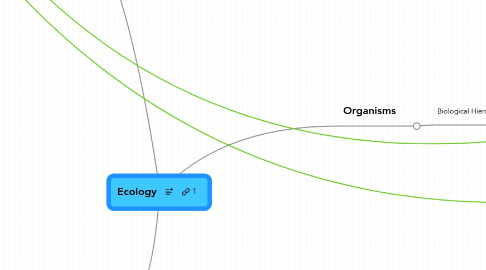
1. Environment
1.1. Biomes
1.1.1. Aquatic
1.1.1.1. Freshwater
1.1.1.1.1. Lakes and Ponds
1.1.1.1.2. Streams and Rivers
1.1.1.1.3. Springs
1.1.1.1.4. Ephemeral ponds
1.1.1.2. Euryhaline
1.1.1.3. Saltwater
1.1.1.3.1. Oceans
1.1.1.3.2. Lakes
1.1.2. Terrestrial
1.1.2.1. Arctic
1.1.2.1.1. Taiga
1.1.2.1.2. Tundra
1.1.2.1.3. Glaciers/ice
1.1.2.2. Temperate
1.1.2.2.1. Desert
1.1.2.2.2. Forests
1.1.2.2.3. Chapparal
1.1.2.2.4. Shrubland
1.1.2.2.5. Grassland
1.1.2.3. Tropical
1.1.2.3.1. Wet forest
1.1.2.3.2. Dry forest
1.1.2.3.3. Cloud forest
1.2. Climate
1.2.1. Radiation
1.2.1.1. Shortwave
1.2.1.1.1. Direct
1.2.1.1.2. Scattered
1.2.1.1.3. Reflected
1.2.1.2. Longwave
1.2.2. Precipitation
1.2.2.1. Gradients
1.2.2.1.1. Altitude
1.2.2.1.2. Latitude
1.2.2.1.3. Continental
1.2.3. Temperature
1.2.3.1. Gradients
1.2.3.1.1. Aquatic
1.2.3.1.2. Terrestrial
1.2.4. Feedbacks
1.2.4.1. positive
1.2.4.2. negative
2. Economics & Society
2.1. Energy
2.1.1. Renewable
2.1.1.1. Wind
2.1.1.2. Solar
2.1.1.3. Hydrogen
2.1.1.4. Biological
2.1.1.4.1. Algae
2.1.1.4.2. Crops
2.1.2. Non-renewable
2.1.2.1. Nuclear
2.1.2.1.1. Uranium
2.1.2.1.2. Plutonium
2.1.2.2. Carbon-based
2.1.2.2.1. Petrolium
2.1.2.2.2. Natural gas
2.1.2.2.3. Coal
2.2. Urban planning
2.2.1. Architecture
2.2.2. Engineering
2.2.3. Transportation
2.3. Biodiversity
2.3.1. Aesthetics/Biophilia
2.3.2. Ecosystem function
2.3.3. Resource management
2.3.3.1. Restoration
2.3.3.2. Preservation
2.3.3.3. Invasives
2.4. Food and Agriculture
2.4.1. Transportation
2.4.2. Farming
2.4.2.1. Land use
2.4.2.2. Fertilizers
2.4.2.3. Genetically modified organisms
2.5. Disease & Public health
2.5.1. Human Disease
2.5.2. Wildlife disease
3. Organisms
3.1. Biological Hierarchy
3.1.1. Individuals
3.1.1.1. Behavior
3.1.1.1.1. Foraging
3.1.1.1.2. Social
3.1.1.1.3. Movement
3.1.1.1.4. Thermoregulation
3.1.1.2. Physiology
3.1.1.2.1. Linked mass-energy budgets
3.1.1.3. Morphology
3.1.1.3.1. Body size
3.1.1.3.2. Biomechanics
3.1.1.3.3. Locomotion
3.1.1.4. Life history
3.1.1.4.1. Demography
3.1.1.4.2. Quantitative genetics
3.1.1.4.3. Allocation
3.1.1.5. Life cycle
3.1.2. Populations
3.1.2.1. Evolution
3.1.2.1.1. Selection
3.1.2.1.2. Genetic drift
3.1.2.1.3. Gene flow
3.1.2.1.4. Mutation
3.1.2.2. Dynamics through time
3.1.2.2.1. Theory
3.1.2.2.2. Patterns
3.1.2.3. Distributions through space
3.1.2.3.1. Source-sink dynamics
3.1.2.3.2. Fragmentation
3.1.3. Communities
3.1.3.1. Stability
3.1.3.1.1. Succession
3.1.3.1.2. Disturbance
3.1.3.1.3. Alternative community states
3.1.3.2. Diversity
3.1.3.2.1. Patterns
3.1.3.2.2. Properties
3.1.3.3. Interactions
3.1.3.3.1. Competition
3.1.3.3.2. Predation
3.1.3.3.3. Mutualism
3.1.3.3.4. Parasitism
3.1.3.3.5. Disease
3.1.4. Ecosystems
3.1.4.1. Processes
3.1.4.1.1. Stoichiometry
3.1.4.1.2. Material cycles
3.1.4.1.3. Energy flow
3.1.4.2. Services
3.1.4.2.1. Pollination
3.1.4.2.2. Water
3.1.4.2.3. Degradation of materials
3.1.5. Biosphere
